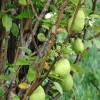 The showy flowers and manageable height of common pear makes it a favorable ornamental landscape tree. Some find the aromatic flowers and sweet edible fruits to be an additional plus; however, a pollinator specimen must be nearby in order for the female tree to produce fruit. Careful consideration should be taken when choosing a planting location, since the soft fruits can be messy if not harvested. This 2-page fact sheet was written by Michael G. Andreu, Melissa H. Friedman, and Robert J. Northrop, and published by the UF Department of School of Forest Resources and Conservation, July 2012.
The showy flowers and manageable height of common pear makes it a favorable ornamental landscape tree. Some find the aromatic flowers and sweet edible fruits to be an additional plus; however, a pollinator specimen must be nearby in order for the female tree to produce fruit. Careful consideration should be taken when choosing a planting location, since the soft fruits can be messy if not harvested. This 2-page fact sheet was written by Michael G. Andreu, Melissa H. Friedman, and Robert J. Northrop, and published by the UF Department of School of Forest Resources and Conservation, July 2012.
http://edis.ifas.ufl.edu/fr361
Tag: Rosaceae
FOR255/FR317 Crataegus marshallii, Parsley Hawthorn
FOR255, a 2-page fact sheet by Michael G. Andreu, Melissa H. Friedman, Mary McKenzie, Heather V. Quintana, and Robert Northrop, describes this small native tree found in open to partially shaded areas along the moist edges or slopes of floodplains, river banks, and wet woodlands throughout the southeastern United States — scientific and common names, description, allergen, and applications. Includes references. Published by the UF School of Forest Resources and Conservation, June 2010.
http://edis.ifas.ufl.edu/fr317